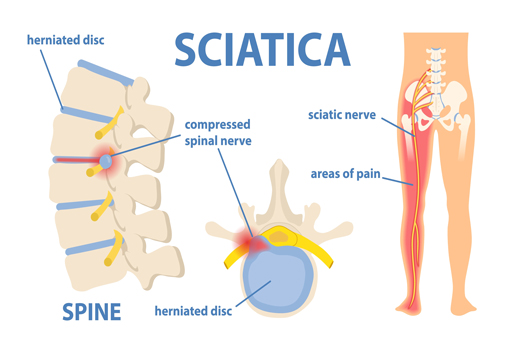
Sciatica refers to symptoms experienced in the sciatic nerve, which starts at the base of the spine and works its way downward. The level of discomfort sciatica causes can vary, although there are some classic symptoms associated with this common condition, such as numbness, tingling sensations, and pain that tends to radiate rather than stay in one place. This article discusses the four main types of sciatica.
1. Neurogenic Sciatica
This type of sciatica occurs when the sciatic nerve is pinched or compressed. It is also the most common type of sciatica, and it is typically caused by a herniated disc in the lower back area. Symptoms commonly associated with this form of sciatica include:
• Pain that radiates to nearby areas such as the thighs or legs
• General weakness within the affected area or that extends to nearby areas
Low back pain that tends to get worse when sitting down
Along with physical discomfort, this type of sciatica may also cause abnormal neurological changes. You might also notice diminished reflexes, sensory issues, or a "pins-and-needles" sensation referred to as paresthesia. If your sciatica is caused by a herniated disc that is not responding to conservative treatment, your doctor may recommend a discectomy or less invasive microdiscectomy.2. Referred Sciatica
Technically, this is not a true form of sciatica. However, the symptoms associated with this form of sciatica mimic classic sciatica-related symptoms. Referred sciatica is caused by the irritation of muscle or joint tissue in the same general area. You may need to have additional treatment for spinal joint issues.
Symptoms associated with this sciatica-like condition include dull, aching pain that may be more noticeable in the legs. However, you will not notice any abnormal neurological changes, meaning you will not experience the numbness and tingling sensations commonly associated with classic or "true" sciatica.
3. Alternating Sciatica
With this form of sciatica, symptoms tend to extend to both legs rather than only one, which is more common with sciatica. Alternating sciatica also tends to be a bit more aggressive than nerve-based sciatica. It is believed to be related to degenerative issues in the sacroiliac (SI) joint, which connects the spine to the hips. Another possible culprit is sacroiliac arthritis.
4. Bilateral Sciatica
In this instance, both ends of the sciatic nerve are impacted. You may experience pain that extends to your hips and buttocks at the same time. This is similar to the symptoms experienced with alternating sciatica. The main difference is the symptoms are more constant and less variable. Bilateral sciatica is typically related to multiple herniated discs, although disc degeneration is another possible source.
Getting an Accurate Diagnosis
It is not always easy to tell which form of sciatica you have so appropriate treatment can be recommended. Many patients respond well to treatment that includes:
• Hot and cold applications
• Anti-inflammatory medication
• Physical therapy
• Lifestyle changes (e.g., getting more sleep, using a more supportive mattress, watching what you eat, exercising regularly)
Patients who have had discectomies for herniated discs may experience sciatica if their discs reherniate, which often occurs if there is a large hole in the outer ring of the disc after surgery. Fortunately, there is a new treatment shown to reduce the risk of reherniation by closing the hole in the disc after a discectomy. This treatment is done immediately following the discectomy—during the same operation—and does not require any additional incisions or time in the hospital. Barricaid was proven 95 percent effective in a study of over 500 patients, meaning 95 percent of patients did not experience a reoperation due to reherniation in the two-year study time frame.
To learn more about the Barricaid treatment, ask your doctor or contact us at 844-288-7474.
For full benefit/risk information, please visit: https://www.barricaid.com/instructions.


Comments